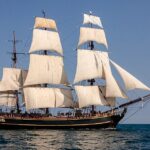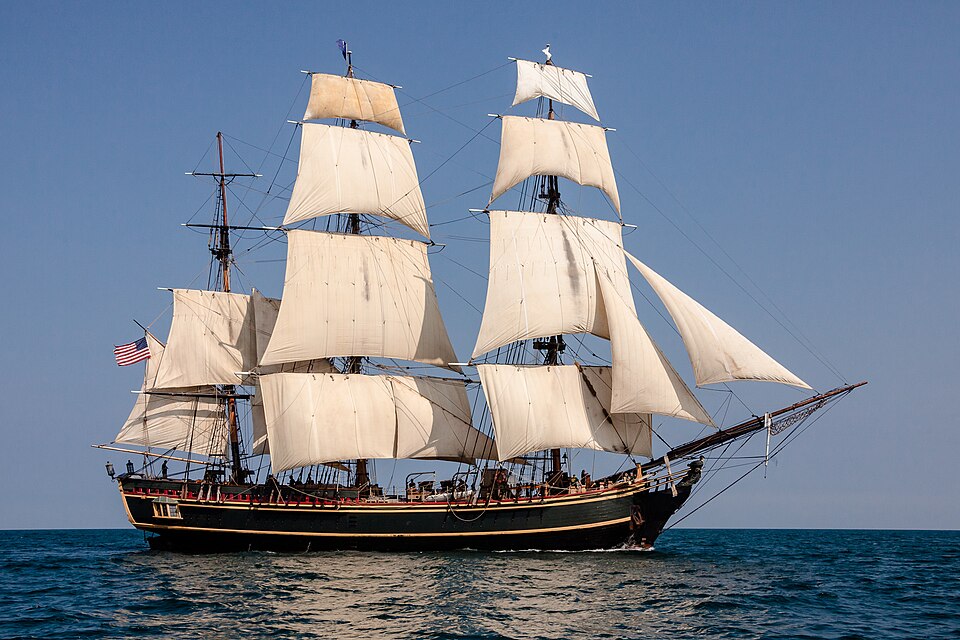
What happened on the Bounty? A mutiny on the HMS Bounty was led by a sailor called Fletcher Christian. The captain and his loyal crew were set adrift in the ship’s launch.
The HMS Bounty was a British merchant ship. It had been built in 1784 and entered service for the Royal Navy in 1787. The Bounty wasn’t a very big ship, but was armed with canons and guns in case of danger. The 18th century period was known as the “Age of Sail” and many of the main European powers were trying to consolidate their colonies, or add more colonies. They were also vying for trade routes. Combat between ships was common, there were pirates, and there were many ships that had a letter of marque, so an armed merchant ship was not that rare. The ship was fitted so that it could carry potted breadfruit plants from Tahiti to the West Indes. The idea was to plant the breadfruit plants there and use them to feed the slaves that serviced the British colonial plantations there. When cooked, apparently, breadfruit has the texture of freshly baked bread and tastes like potatoes. A single breadfruit tree produces 200 or more fruit a year, making it a very high yield tree and a good source of cheap food.
The HMS Bounty set sail for Tahiti in 1787. The captain of the ship was Lieutenant William Bligh. He had sailed with Captain Cook on one of his voyages, but had basically been laid off since then. He took the captainship of the Bounty to get back on a ship, but at a considerably reduced salary. He had 46 men in his crew. They were all experienced. Bligh chose the majority of the crew, especially a sailor called Fletcher Christian. Christian was from a wealthy family, and he had chosen to be a sailor over his family’s objections. He had sailed twice with Bligh and the two of them had formed a good relationship. So good, in fact, that Christian was willing to do the voyage without pay.
The voyage out to Tahiti was not much out of the ordinary. Bligh was perhaps a little too strict. The ship got caught in weather a few too many times. A few sailors had to be disciplined. But none of this was really that different to any other ship. It took them about a year to get there. They left England in November 1787 and arrived in Tahiti in October 1788. The problems began when they arrived in Tahiti. They had to dig up and load 1,000 breadfruit plants onto the ship. It took them five months altogether. During that time the crew lived on Tahiti, settled in a village. The sailors all found Tahiti to be a tropical paradise, and they all took Tahitian women. Whether this was with consent or not, I don’t know. Fletcher Christian fell in love with a Tahitian woman called Mauatua, but he renamed her Isabella.
While they were in Tahiti, discipline slowly got worse. Bligh found it harder and harder to get the sailors to carry out his orders. They liked living the island life too much. He had various flogged and he had to exert his authority a lot. He was particularly hard on Christian. By the end of March 1789, they were ready to leave and Bligh had the crew prepare the ship. They obviously didn’t want to leave, or that could be obvious because of hindsight. They set sail on April 4th, 1789, and discipline was bad. Bligh had several men flogged again and he tried to enforce his rules. By April 28th, 1789, the sailors appear to have had enough of Bligh and of sea life. In the middle of the night, Fletcher Christian and 25 sailors woke Bligh up and held him at bayonet point. They forced him and anybody loyal to him into the boat’s long boat, which was about 8 m long, then set it adrift. This was as good as killing them without having to get their hands dirty. There were a lot of sailors loyal to Captain Bligh and 19 sailors climbed into the boat designed for about 10. Christian then sailed the Bounty back to Tahiti, but they thought they would be captured there if word reached England, so they sailed on and ended up on the tiny islands that are now called the Pitcairns. They set up a colony. They were relatively happy for a while, but relations between the mutineers and the native people gradually broke down. In 1794, many of the mutineers, including Fletcher Christian were murdered by the native people. Several of them survived and many of the people who live on the islands now are descended from them.
What happened to Captain Bligh? He was an exceptionally good navigator and he managed to sail the tiny ship roughly 6,000 km to Australia, where they ended up in a Dutch colony, where they managed to get passage back to England by 1790, almost three years after they had set sail. Bligh was pardoned of all wrongdoing and went on to Captain other ships. He became governor of New South Wales, in Australia in 1806. He returned to England and died of cancer in 1817. And this is what I learned today.
Sources
https://en.wikipedia.org/wiki/Mutiny_on_the_Bounty
https://en.wikipedia.org/wiki/William_Bligh
https://en.wikipedia.org/wiki/HMS_Bounty
https://en.wikipedia.org/wiki/Breadfruit
https://www.rmg.co.uk/stories/topics/mutiny-on-bounty
https://www.history.com/this-day-in-history/april-28/mutiny-on-the-hms-bounty Image By Dan Kasberger – Own work, CC BY-SA 3.0, https://commons.wikimedia.org/w/index.php?curid=25881520

